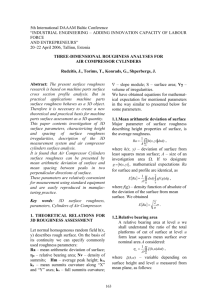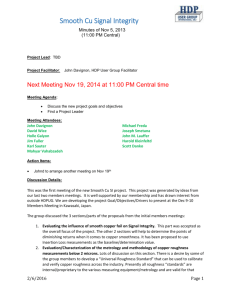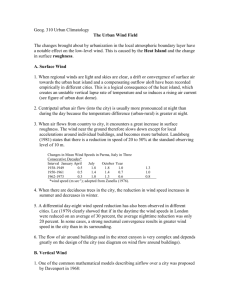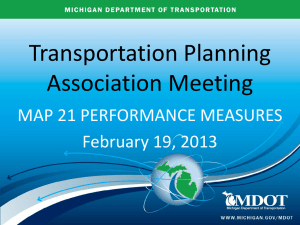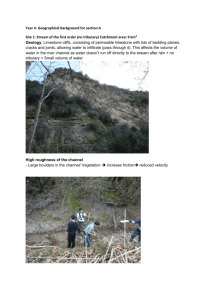Part R35 Surface Characteristics
advertisement
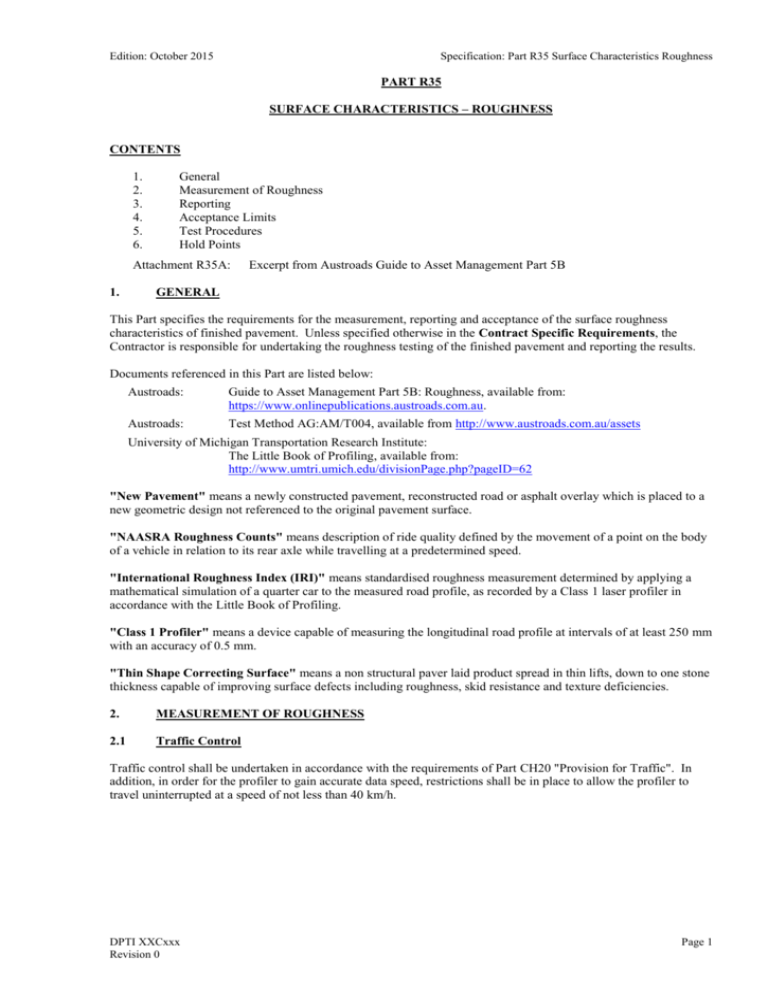
Edition: October 2015 Specification: Part R35 Surface Characteristics Roughness PART R35 SURFACE CHARACTERISTICS – ROUGHNESS CONTENTS 1. 2. 3. 4. 5. 6. General Measurement of Roughness Reporting Acceptance Limits Test Procedures Hold Points Attachment R35A: 1. Excerpt from Austroads Guide to Asset Management Part 5B GENERAL This Part specifies the requirements for the measurement, reporting and acceptance of the surface roughness characteristics of finished pavement. Unless specified otherwise in the Contract Specific Requirements, the Contractor is responsible for undertaking the roughness testing of the finished pavement and reporting the results. Documents referenced in this Part are listed below: Austroads: Guide to Asset Management Part 5B: Roughness, available from: https://www.onlinepublications.austroads.com.au. Austroads: Test Method AG:AM/T004, available from http://www.austroads.com.au/assets University of Michigan Transportation Research Institute: The Little Book of Profiling, available from: http://www.umtri.umich.edu/divisionPage.php?pageID=62 "New Pavement" means a newly constructed pavement, reconstructed road or asphalt overlay which is placed to a new geometric design not referenced to the original pavement surface. "NAASRA Roughness Counts" means description of ride quality defined by the movement of a point on the body of a vehicle in relation to its rear axle while travelling at a predetermined speed. "International Roughness Index (IRI)" means standardised roughness measurement determined by applying a mathematical simulation of a quarter car to the measured road profile, as recorded by a Class 1 laser profiler in accordance with the Little Book of Profiling. "Class 1 Profiler" means a device capable of measuring the longitudinal road profile at intervals of at least 250 mm with an accuracy of 0.5 mm. "Thin Shape Correcting Surface" means a non structural paver laid product spread in thin lifts, down to one stone thickness capable of improving surface defects including roughness, skid resistance and texture deficiencies. 2. MEASUREMENT OF ROUGHNESS 2.1 Traffic Control Traffic control shall be undertaken in accordance with the requirements of Part CH20 "Provision for Traffic". In addition, in order for the profiler to gain accurate data speed, restrictions shall be in place to allow the profiler to travel uninterrupted at a speed of not less than 40 km/h. DPTI XXCxxx Revision 0 Page 1 Edition: October 2015 2.2 Specification: Part R35 Surface Characteristics Roughness Measurement Roughness shall be measured with either one of the following Class 1 profilers over the sections of pavement specified: (a) Two Laser Profiler (b) Multi-Laser Profiler (c) Walking Profiler. Where a Walking Profiler is to be used the maximum length over which measurements may be taken in one run is 100 m. Measurements, daily checks and calibration of roughness measuring devices shall be undertaken in accordance with the manufacturer's instructions and where applicable, the DPTI procedures listed in Clause 5 "Test Procedures". The equipment shall measure longitudinal profile in both wheel paths over the wavelength range 0.5 to 50 m. Sampling shall be performed at a maximum interval of 250 mm, in each wheel path of each lane in the proposed direction of travel of traffic. Wheel paths are deemed to be 750 mm from the centre of each lane (width of dedicated parking lanes to be excluded from lane width). The location of the start and finish chainages where roughness testing is to be undertaken shall be clearly marked out. For measurements where no pavement marking is present, including granular base, the lane lines and proposed medians at 30 m intervals shall be clearly marked out. From the measured profile a wheel path IRI and lane IRI (Quarter Car) shall be determined. The lane IRI may be converted to NAASRA counts using the following equation: NAASRA (counts/km) = 26.49 IRIlane - 1.27 (Quarter Car) Sections measuring less than the specified lot size shall be incorporated into the adjacent section. Data shall be collected in the sequence specified in Table 2.2 within 5 days of completion of the relevant pavement layer. TABLE 2.2 - TESTING SEQUENCE OF VARIOUS PAVEMENT TYPES PAVEMENT TYPE TESTING SEQUENCE Spray seal on granular base Before application of spray seal and after completion of the final wearing surface. Asphalt Overlays and Thin Shape Correcting Surfaces (less than 50 mm nominal thickness) After all rehabilitation work is complete but before asphalt overlay has commenced. Also required on final wearing course. Asphalt pavement greater than 50 mm thick Prior to and after the application of the final wearing course. The Contractor shall ensure that: (a) the pavement is free of loose material and debris when testing is undertaken; (b) for unbound granular bases, measurements shall be undertaken prior to sweeping of the pavement; and (c) free water is not present on the pavement when testing is undertaken. DPTI XXCxxx Revision 0 Page 2 Edition: October 2015 2.3 Specification: Part R35 Surface Characteristics Roughness Repeatability Requirements Prior to measurements commencing a series of 5 runs for each operator over the section of road indicated in the Contract Specific Requirements, shall be undertaken, unless proof of such repeatability testing, carried out in the 6 months prior to the testing can be provided. All 5 runs shall be completed on the same day over the same section of road. The results of each of the 5 runs shall meet the repeatability requirements of Austroads Test Method AG:AM/T004. Only those operators that have satisfied this repeatability requirement will be permitted to undertake roughness measurements. The test data to be supplied under the requirements of this Part shall be provided prior to any further data collection taking place. Any anomalies shall constitute a HOLD POINT. If any electronic or mechanical failure occurs on the test vehicle that are likely to affect the repeatability or accuracy of data collected, evidence shall be provided that demonstrates that results before and after the incident match. When undertaking actual site measurements the results of each run shall not deviate from the mean of the runs for each 100 m lot by more than 10%. 3. REPORTING For reporting purposes each lane will be divided into 100 m sections. The roughness value of each section shall be taken as the average count taken over 3 runs in the proposed direction of travel. A report detailing results of roughness testing must be presented in both electronic and hard copy forms within the timeframe detailed below: (a) Results of testing undertaken prior to the application of the final wearing surface shall be presented a minimum of 2 workings days prior to the final wearing surface being applied. (b) Results of testing undertaken on the final wearing course shall be presented within 5 working days after measurements are taken. The report shall contain the following information: (a) Road number. (b) Surfacing type. (c) Survey date (yymmdd). (d) Daily calibration check results. (e) Section length (m). (f) Start and Finish Chainage referenced to the road running distance or chainage. (g) Direction of travel and lane number. (h) Left wheel path roughness (IRI). (i) Right wheel path roughness (IRI). (j) Quarter car roughness (IRI) for each run. (k) Quarter car roughness (NAASRA counts) for each run. (l) Mean lane roughness together with the percentage deviation from the mean. Lane identification shall comply with the following convention: (a) the lane where the direction of travel coincides with increasing road running distance is deemed to be the left lane. (b) lane numbers (i.e. L1, L2…) shall increase with distance from the median or centre line. All results shall be presented with other lot documentation for the relevant pavement layer in an approved electronic format. Provision of an electronic copy of the report and raw test results for each pavement layer shall constitute a HOLD POINT. DPTI XXCxxx Revision 0 Page 3 Edition: October 2015 Specification: Part R35 Surface Characteristics Roughness 4. ACCEPTANCE LIMITS 4.1 General The finished surface of the pavement shall have a smooth longitudinal profile and the measured roughness shall not exceed the values specified in this Clause. NAASRA roughness values shall be calculated from the IRI value using Table H2 from the Austroads Guide to Asset Management Part 5B (reproduced in Attachment R35A) 4.2 New Pavements Unless Sub-clause 4.3 "Thin Overlays – Dependence on Underlying Layers" or Sub-clause 4.4 “Exclusions” applies, the mean IRI & NAASRA roughness for each 100 m section of wearing course shall not exceed the maximum values specified in the Table 4.2. TABLE 4.2- MAXIMUM ROUGHNESS LEVELS Low Speed Environment (speed limit less than or equal to 70 km/h) High Speed Environment (speed limit in excess of 70 km/h) Motorway, Expressway or Freeway (speed limit in excess of 70 km/h) 1.6 m/km (IRI) 1.4 m/km (IRI) 1.0 m/km (IRI) 40 counts/km (NAASRA) 35 counts/km (NAASRA) 25 counts/km (NAASRA) The "speed limit" referred to above is the speed limit imposed for the finished Works. 4.3 Thin Overlays - Dependence on Underlying Layers Where the construction of the underlying layer does not form part of the work under the Contract, and the total bituminous layer thickness is less than 50 mm, the higher of the maximum roughness levels indicated in Table 4.2 or that derived from the following equations shall not be exceeded: (NAASRA Count before overlay x 0.55) + 5 c/km (IRI before overlay x 0.55) + 0.2 m/km 4.4 Exclusions Unless specified otherwise in the Contract Specific Requirements, those areas that are to be excluded from the requirements of this Part are: 5. (a) roundabouts; (b) railway lines and Bridge Joints (35 m after the event); (c) intersections (stop bar to stop bar); (d) inspection pit covers and surface defects related to inspection pit covers within the wheel paths (15 m including the event); (e) side streets specified in the Contract Specific Requirements deemed to affect pavement ride quality (the width of the side street plus 30 m after the event); and (f) surface defects related to existing culverts which are not part of the work under the Contract (width of culvert plus 30m after the event). TEST PROCEDURES The Contractor shall use the following test procedures (refer http://www.dtei.sa.gov.au/dtei_contractor_documents) to verify conformance with the Specification: DPTI XXCxxx Revision 0 Page 4 Edition: October 2015 Specification: Part R35 Surface Characteristics Roughness TEST TEST PROCEDURE Determination of Pavement Surface Roughness using the Laser Profiler TP348 Determination of Pavement Surface Roughness Using the Walking Profiler TP350 6. HOLD POINTS The following is a summary of Hold Points referenced in this Part: CLAUSE REF. HOLD POINT RESPONSE TIME 2.3 Anomalies in test data 1 working day 3 Presentation of results 1 working day DPTI XXCxxx Revision 0 Page 5 Edition: October 2015 Specification: Part R35 Surface Characteristics Roughness ATTACHMENT R35A EXCERPT FROM AUSTROADS GUIDE TO ASSET MANAGEMENT PART 5B: ROUGHNESS (2007) Table H 2: Conversion tables for IRI and NRM roughness values NRM (counts/km) IRI (m/km) IRI (m/km) NRM (counts/km) 20 0.8 1.0 25 30 1.2 1.5 38 40 1.6 2.0 52 50 1.9 2.5 65 60 2.3 3.0 78 70 2.7 3.5 91 80 3.1 4.0 105 90 3.4 4.5 118 100 3.8 5.0 131 110 4.2 5.5 144 120 4.6 6.0 158 130 5.0 6.5 171 140 5.3 7.0 184 150 5.7 7.5 197 160 6.1 8.0 211 170 6.5 8.5 224 180 6.8 9.0 237 190 7.2 9.5 250 200 7.6 10.0 264 210 8.0 12.0 317 220 8.4 14.0 370 230 8.7 16.0 423 240 9.1 18.0 476 250 9.5 20.0 529 Note: IRI values are quarter car, i.e. IRIqc. ____________ DPTI XXCxxx Revision 0 Page 6


